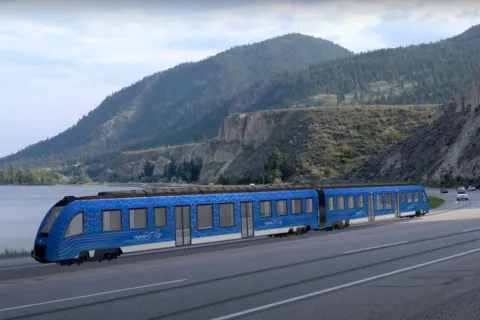UBC engineering professor researches electric passenger light rail for Okanagan Valley

Anyone who has ever been stuck in gridlock while driving over Kelowna’s William R. Bennett Bridge or any Okanagan community can appreciate the thought that there has to be a better alternative than Highway 97 to navigate the busy corridor.
And a UBC Okanagan professor says there is.
Dr. Gordon Lovegrove, who teaches in UBC Okanagan’s School of Engineering, has studied the feasibility of an affordable passenger train patterned after a similar concept started in Karlsruhe, Germany 40 years ago.
“Hydrail tram-trains—powered by a hydrogen fuel cell/battery—is a passenger rail that acts like a tram in cities and like a train between communities. This is a new concept to North America,” explained Dr. Lovegrove. “They are self-powered, low-floor and a zero-emission technology, which differs from typical heavy-rail, high-floor, locomotive-pulled passenger cars. This gives hydrail the advantage of being able to climb hills and more affordable than highway widening.”
Dr. Lovegrove said the Okanagan’s booming tourism and population growth affect the more than 500,000 residents in communities connected mainly by Highway 97. The majority of travel is by cars, which increases the highway’s gridlock and risk of collisions. He cited recent surveys of residents, First Nations communities and businesses, coupled with joint municipal and provincial government studies that reveal the Okanagan Valley needs more than traditional auto-oriented solutions such as road widening and bypasses—options he calls ineffective and costly.
"A passenger rail that acts like a tram in cities and like a train between communities."
That opened the door for the researchers to study the technical and economic feasibility of an Okanagan Valley Electric Regional Passenger Rail (OVER PR) service. The study, published recently in the journal Sustainability, is the first of its kind in North America and one of the first published worldwide.
“To address growing inter-city transportation, safety, congestion and climate resilience challenges in the Okanagan Valley, we found that even in our Canadian climate and hilly terrain, hydrail tram-trains are technically feasible. And they would be more affordable than widening our highways and promoting more pollution and congestion. However, it is up to communities to decide if and where it would run.”
Dr. Lovegrove noted he deliberately analyzed the undulating Highway 97 route with its steep hills, as opposed to conventional near-flat freight routes, as the toughest test of its feasibility.
Assuming Highway 97 was chosen, OVER PR would connect cities and airports throughout the valley with a one-way trip from Osoyoos to Kamloops taking about four hours, comparable to driving a car. The tram-train could travel at higher speeds, about 90 km/h between cities, but at lower tram-specific speeds in cities, with modern transit priority signals designed to bypass delays at intersections.
“Using embedded rails, sharing existing and HOV lanes as well as highway rights-of-way, or medians, between cities, would drastically reduce the need for land acquisition without taking away capacity. The route would also be designed to integrate with regional bus services to construct an optimal arrival and departure schedule,” he said.
With OVER PR ridership expected to be more than 13,000 passengers per day, there is something in it for even those who could not make the jump from driving to using the tram-train, as it would mean less traffic congestion and travel delays.
"They would be more affordable than widening our highways and promoting more pollution and congestion."
“Hydrail combined with tram-train technology has never been tried in Canada, yet hydrogen trains present advantages compared with electrification by eliminating the requirement for expensive infrastructure such as catenaries (above ground wires) and substations. It also grants the flexibility to operate in remote rural areas or difficult terrain where electrification might pose challenges, which improves its overall effectiveness and adaptability. When hydrogen production is coupled with other forms of renewable energy generation, the environmental benefits are favourable.”
The study states the system, similar to ones that operate in California’s Napa Valley or the Karlsruhe region in Germany, can have economic, social and ecological benefits for tourists and residents.
Dr. Lovegrove’s research suggests that over 30 years, and using the same cost-benefit analysis template used by provincial policy analysts, OVER PR benefits total more than $45 billion, and outweigh its capital and operating costs by nine to one, with many more benefits than widening Highway 97.
“The Okanagan Valley is expected to continue with significant population growth, tourism and traffic congestion which leads to increased greenhouse gas emissions, as well as more vehicles and highway fatalities,” Dr. Lovegrove said. “If communities agree to proceed with OVER PR planning this valley-long zero-emission, passenger rail service could significantly enhance transport equity, safety and congestion while also providing a more affordable, resilient and environmentally friendly choice for valley residents, businesses and tourists.”



